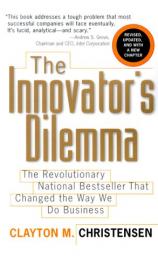Excerpt
Excerpt
The Innovator's Dilemma

Chapter One
How Can Great Firms Fail?
Insights from the Hard Disk Drive Industry
When I began my search for an answer to the puzzle of why the best firms can fail, a friend offered some sage advice. "Those who study genetics avoid studying humans," he noted. "Because new generations come along only every thirty years or so, it takes a long time to understand the cause and effect of any changes. Instead, they study fruit flies, because they are conceived, born, mature, and die all within a single day. If you want to understand why something happens in business, study the disk drive industry. Those companies are the closest things to fruit flies that the business world will ever see."
Indeed, nowhere in the history of business has there been an industry like disk drives, where changes in technology, market structure, global scope, and vertical integration have been so pervasive, rapid, and unrelenting. While this pace and complexity might be a nightmare for managers, my friend was right about its being fertile ground for research. Few industries offer researchers the same opportunities for developing theories about how different types of change cause certain types of firms to succeed or fall or for testing those theories as the industry repeats its cycles of change.
This chapter summarizes the history of the disk drive industry in all its complexity. Some readers will be interested in it for the sake of history itself. But the value of understanding this history is that out of its complexity emerge a few stunningly simple and consistent factors that have repeatedly determined the success and failure of the industry's best firms. Simply put, when the best firms succeeded, they did so because they listened responsively to their customers and invested aggressively in the technology, products, and manufacturing capabilities that satisfied their customers' next-generation needs. But, paradoxically, when the best firms subsequently failed, it was for the same reasons-they listened responsively to their customers and invested aggressively in the technology, products, and manufacturing capabilities that satisfied their customers' next-generation needs. This is one of the innovator's dilemmas: Blindly following the maxim that good managers should keep close to their customers can sometimes be a fatal mistake.
The history of the disk drive industry provides a framework for understanding when "keeping close to your customers" is good advice-and when it is not. The robustness of this framework could only be explored by researching the industry's history in careful detail. Some of that detail is recounted here, and elsewhere in this book, in the hope that readers who are immersed in the detail of their own industries will be better able to recognize how similar patterns have affected their own fortunes and those of their competitors.How Disk Drives Work
Disk drives write and read information that computers use. They comprise read-write heads mounted at the end of an arm that swings over the surface of a rotating disk in much the same way that a phonograph needle and arm reach over a record; aluminum or glass disks coated with magnetic material; at least two electric motors, a spin motor that drives the rotation of the disks and an actuator motor that moves the head to the desired position over the disk; and a variety of electronic circuits that control the drive's operation and its interface with the computer. See Figure 1.1 for an illustration of a typical disk drive.
The read-write head is a tiny electromagnet whose polarity changes whenever the direction of the electrical current running through it changes. Because opposite magnetic poles attract, when the polarity of the head becomes positive, the polarity of the area on the disk beneath the head switches to negative, and vice versa. By rapidly changing the direction of current flowing through the head's electromagnet as the disk spins beneath the head, a sequence of positively and negatively oriented magnetic domains are created in concentric tracks on the disk's surface. Disk drives can use the positive and negative domains on the disk as a binary numeric system--1 and 0--to "write" information onto disks. Drives read information from disks in essentially the opposite process: Changes in the magnetic flux fields on the disk surface induce changes in the micro current flowing through the head.Emergence of the Earliest Disk Drives
A team of researchers at IBM's San Jose research laboratories developed the first disk drive between 1952 and 1956. Named RAMAC (for Random Access Method for Accounting and Control), this drive was the size of a large refrigerator, incorporated fifty twenty-four-inch disks, and could store 5 megabytes (MB) of information (see Figure 1.2). Most of the fundamental architectural concepts and component technologies that defined today's dominant disk drive design were also developed at IBM. These include its removable packs of rigid disks (introduced in 1961)...
Excerpted from The Innovator's Dilemma © Copyright 2012 by Clayton M. Christensen. Reprinted with permission by HarperCollins. All rights reserved.
The Innovator's Dilemma
- paperback: 320 pages
- Publisher: HarperCollins Publishers
- ISBN-10: 0066620694
- ISBN-13: 9780066620695







